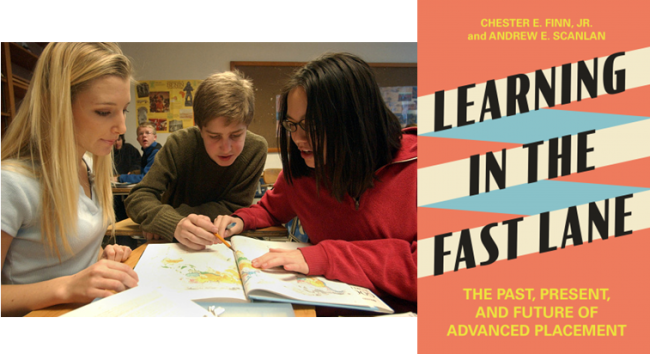You have /5 articles left.
Sign up for a free account or log in.

Getty Images
The College Board’s Advanced Placement program now evaluates more than three million high school students each academic year, and is now itself being deeply evaluated by one of the most prominent conservative voices in education.
Learning in the Fast Lane: The Past, Present and Future of Advanced Placement, which will be released by Princeton University Press in September, covers the 65-year evolution of AP, which originally began as a medium for elite high schools to provide colleges with a standardized distinction for their achieving students -- the best and brightest in the country. One of those students was co-author Chester Finn Jr., a longtime education reform researcher and leader at the Fordham Institute, who said he was part of the "early rounds" of students taking AP.
The program has since expanded rapidly, outstretching its offerings to many more disadvantaged and public high schools, and it continues to grow, as the College Board saw a 33 percent increase in private schools and a 14 percent increase in public schools that offer AP curriculum from 2013 to 2018, said Trevor Packer, head of the AP program and a source Finn and co-author Andrew Scanlan frequent in their book. Finn and Scanlan deliver praise for the AP program overall, and what it has done for students who historically haven't been given access to college-level or even advanced classes. But they believe, as does the College Board, that more should be done to elevate disadvantaged students' scores on the exams.
Scanlan, a research and policy associate at the Fordham Institute and Irishman who came to the U.S. three years ago to study education, said his interest in conducting in-depth research on the AP program stems from its narrow resemblance to his home country’s advanced learning structure, he said, and its role in addressing the “excellence gap” between high-achieving, elite, white, Ivy-bound high school students and those who have much fewer pathways to college.
“The College Board, over the last couple of decades and even before that, has really been pushing AP as a lever for lifting less traditionally AP students -- more students from low-income backgrounds or students of color,” Scanlan said. “I wanted to understand more about when that role really came on board, when that became another major engine of the program.”
While significant strides have been made -- about 70 percent of all public U.S. high schools in 2017 offered AP examination in some form, versus just over half of them in 1997, according to College Board and National Center for Education data -- the book identifies the declining exam-passage rate among black and Latino students as the most pressing issue facing AP.
The first facet of this problem, Finn said, is getting the courses and exams to these students, which has improved but is still a weak link.
“Then comes the question of creating greater equalization of outcomes, and that remains a big challenge,” he said. “It's not something that high schools alone can deal with, because some of it is these crappy middle schools, some of it are the problems these kids have in other parts of their lives … [The College Board] can't overcome all of these other things that are beyond, essentially, the high schools’ controls.”
AP course material itself, and material leading up to APs, is potentially not taught as effectively in struggling schools with fewer resources, which are identified as low-income, urban or rural, and filled mostly with students of color. And the College Board is in no way satisfied with that reality, Packer said.
“We’re not happy with the fact that many students aren’t receiving equitable prep for AP, so there are score gaps,” Packer said. “That’s not something that we can be content with, by any means. If you’re an AP student, we want you to have those same, high-quality resources no matter where you live and what teacher you have.”
The College Board identified preparation -- of both students to learn AP material and teachers to teach it -- as the largest contributor to declining passage rates for these disadvantaged students. During the 2020 school year, it will introduce Pre-AP courses as an option during students’ first years of high school to prepare for 11th and 12th grade, when most students start AP. As Finn and Scanlan’s extensive research shows, students who are routinely exposed to the advanced curriculum early on are much more likely to improve scores, but the current way to get from a 2 to a 4 or 5 on the test is through repeated attempts at exams in the same or similar subject.
“If you get a 2, it means you've learned something,” Scanlan said. “Maybe it's not a 3, but to see those 1s turning into 2s, some of the school leaders and teachers on the ground are saying that's progress. It's not an easy, straightforward fight, but there's a story in the numbers there.”
As for educator-focused strategies for improvement, there’s also AP Classroom, a new College Board system that launched Thursday, which provides preparation materials for AP instructors and, notably, will help teachers in rural high schools who often lack access, with exam practice and curriculum supplements. About 24,000 classrooms got onto the system during its first day, Packer said.
But while some schools find value in gravitating closer and closer to AP’s structured curriculum, independent, forward-thinking schools with more funding, like the ones the College Board focused on during AP’s beginnings, are choosing to phase out AP courses altogether. In 2007-08, the College Board began requiring schools to submit AP curriculum for approval, Finn said, and some independent schools took issue.
In Learning in the Fast Lane, Finn and Scanlan nod to these schools’ efforts and respect their “freedom to pilot different ways of doing things,” which includes instruction constructed directly by teachers, not a national, standardized curriculum based around a single exam.
Many of the non-AP schools were part of the Independent Curriculum Group, which merged this month with One Schoolhouse, an organization that provides course programming and professional development centered around “personalized learning.” As of July 2018, the ICG had 69 member schools that did not offer any AP courses, according to a list on the group’s website. But these schools continue to help students access, and in some cases, prepare for AP exams if families decide they want the scores as an indicator for college admissions officers, said Peter Gow, who used to run the ICG and is now independent curriculum resource director for One Schoolhouse.
“I haven’t heard, really in a long time, anyone building a case against AP,” Gow said. “It’s more of a matter of [independent schools] doing their own thing, rather than something wrong with the [AP] program … Schools began to think -- ‘we have our own issues.’ They were wondering, ‘Is this particular program limiting our ability to offer our students what they’re interested in?’”
The Urban School in San Francisco has never offered AP-related classes, said Jonathan Howland, the school’s dean of faculty, because they believe their teachers can construct advanced curricula much better than the College Board’s, and better than most colleges’, though Urban does still offer study help for AP exams. In Howland’s words, Urban “not only does a lot of AP, we do a lot better.”
“We neither encourage or disallow [students taking AP exams],” he said. “It’s a tweener thing. For a school like ours, where students are applying to a lot of selective colleges, the advantage of doing well on APs is kind of removed. At best, it might get you a higher placement in a discipline or get you out of an introductory class.”
Finn and Scanlan are critical of this approach in their book and count it as somewhat elitist: since AP is now provided at tens of thousands of “standard” schools, it’s lost its lore and rigor, and the private schools need to distinguish themselves to keep their business models afloat, they argue.
“AP is so much more ubiquitous in the country than it ever has been; it's just not a unique marker for high schools who are trying to mark themselves out as different for whatever reason, or even for universities that are trying to mark themselves as different to the college down the road,” Scanlan said.
And yet, students and parents at these independent schools still want the AP marker, in addition to top education. At Urban, “the principal drive is bragging rights,” Howland said.
“Most of these private schools are ditching AP in a hypocritical way,” Finn said. “They are not teaching College Board-sanctioned AP classes, but they are administering AP exams and they are taking the scores seriously and boasting about the scores in the information they publicize about their school.”
But the dissent among these top secondary and postsecondary schools does not come close to making a dent in the AP program’s popularity, Packer said, nor the College Board’s financial intake from the program, which is the nonprofit’s biggest source of revenue.
More than 99 percent of colleges provide credit for AP scores of 4 or 5, and sometimes 3, Packer said. More than half of states require their affiliated institutions to give credit for AP scores of 3 or better, Finn said. And to repeat, more than 1,000 additional private schools actually implemented AP courses over the past five years, plus, more than 1,000 public colleges and universities expanded their credit offerings for high AP exam scores just in the 2017-18 academic year.
“The public statement recently made by eight D.C. independent schools created the perception that independent schools were dropping AP, but in the data, that’s not what we see,” Packer said.
Bottom line, the data show that AP is still expanding, and it’s reaching more students in the forgotten corners and crevices of the American education system. Learning in the Fast Lane concludes that AP has a stronghold and reach that’s difficult to break, even with curriculum innovation or competing college-level programs, like International Baccalaureate and dual enrollment.
Independent schools “couldn’t get away from it if they wanted to,” Finn said.




